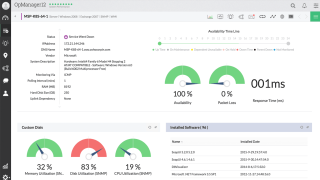6 Alat Pengurusan Rangkaian Terbaik yang Menjejaki Prestasi
Pasaran perisian pengurusan rangkaian sangat sesak. Pintasan carian anda dengan mengikut cadangan kami tentang alat pengurusan rangkaian terbaik.
IIS , singkatan untuk Perkhidmatan Maklumat Internet , dan dahulunya dikenali sebagai Pelayan Maklumat Internet, ialah pelayan web daripada Microsoft yang direka untuk digunakan dengan produk Windows, bermula dengan keluarga NT.
Pelayan web ini digunakan untuk membantu pengguna Windows mengehoskan pelbagai jenis kandungan di web, seperti fail media, dokumen atau tapak web yang lengkap. Pada masa ini, Apache ialah pelayan web Windows yang paling popular, diikuti rapat oleh IIS, yang agak mengagumkan.
Apakah IIS?
IIS ialah pelayan web yang mudah dibiasakan, terima kasih kepada Antara Muka Pengguna Grafik (GUI) intuitifnya yang membolehkan anda mengurus tapak web yang dikaitkan dengan perkhidmatan dan pengguna berkaitannya . GUI IIS memudahkan untuk mereka bentuk, menyesuaikan, mengkonfigurasi dan menerbitkan tapak web dari satu lokasi.
Ia mempunyai alat pengurusan laman web terbina dalam yang dipanggil Pengurus IIS yang boleh anda gunakan untuk melaraskan pilihan seperti tetapan keselamatan, parameter prestasi, pilihan pengelogan serta halaman ralat atau nilai lalai untuk tapak web yang anda tadbir.
Dari sudut pandangan teknikal, IIS agak serba boleh, memandangkan ia boleh melayani halaman web standard dan dinamik sama, tanpa usaha yang ketara. Oleh itu, anda boleh menggunakannya untuk mencipta dan menerbitkan halaman web HTML, tetapi senang mengetahui bahawa anda juga boleh mengurus halaman PHP dan aplikasi ASP.NET.
Terima kasih kepada fleksibilitinya, IIS boleh menjalankan skrip dan aplikasi yang terkandung dalam halaman web dinamik dan memaparkan hasilnya ke skrin pelayar web pelawat. Dengan tapak web statik prosesnya lebih mudah: IIS hanya menghantar kandungan HTML dan imej (jika ada) ke pelayar web pelawat.
Apakah tujuan IIS?
Memandangkan ia mendapat manfaat daripada sokongan penuh Microsoft, dan hakikat bahawa ia terdiri daripada banyak ciri lanjutan, IIS membuat pilihan yang bagus untuk mencipta dan mengurus tapak web komersial, seperti e-kedai atau tapak web portfolio promosi.
Kelemahannya ialah menggunakan IIS untuk tujuan komersial juga bermakna anda memerlukan lesen komersial. Tambahan pula, harga jenis lesen ini berbeza-beza bergantung pada bilangan pengguna yang ingin anda sertakan.
Oleh itu, kami telah menetapkan bahawa IIS boleh digunakan untuk mencipta dan mengehoskan tapak web, serta fakta bahawa ia menyokong kandungan web statik dan dinamik. Walau bagaimanapun, IIS adalah lebih daripada itu. Sebagai contoh, anda boleh menggunakan sokongan modul terbina dalam untuk meningkatkan kefungsian pelayan anda.
Anda boleh memasang modul penstriman pada pelayan anda supaya pelawat tapak web anda boleh mendapat manfaat daripada kandungan media penstriman. Anda juga boleh menggunakan modul Tulis Semula URL yang membolehkan anda mencipta peraturan pelaksanaan URL yang berkuasa supaya pelawat dapat mengingatinya dengan mudah dan enjin carian boleh menemuinya dengan lebih cepat.
Oleh itu, tidak perlu dikatakan bahawa jika anda memerlukan cara cepat untuk mencipta dan menerbitkan tapak web, IIS ialah salah satu cara terbaik untuk melakukannya. Cara terbaik masih kekal sebagai HTTP Apache kerana ia merupakan sumber terbuka dan membenarkan anda menggunakannya secara percuma, tanpa mengira bilangan pengguna.
sejarah versi IIS
Perlu dinyatakan bahawa pada mulanya, IIS dimaksudkan sebagai alternatif kepada pelayan web yang dibangunkan sebagai projek penyelidikan. Projek pelayan web pertama yang ditandatangani Microsoft telah diedarkan sebagai perisian percuma dan direka bentuk untuk EMWAC (Pusat Akademik Microsoft Windows NT Eropah).
Walau bagaimanapun, memandangkan pelayan EMWAC tidak dapat mengendalikan semua volum trafik yang pergi ke tapak web microsoft.com, projek itu telah digugurkan dan Microsoft membangunkan pelayan webnya sendiri dalam bentuk IIS.
Satu aspek yang ketara ialah kebanyakan versi IIS dikeluarkan dengan atau bersama versi sistem pengendalian Windows. Sudah tentu, ketika itu IIS hanyalah bayangan bagaimana kita mengenalinya hari ini; sebenarnya, setiap keluaran Windows boleh berfungsi sebagai pusat pemeriksaan untuk evolusi IIS.
Jika anda bercadang untuk menggunakan IIS, cuba kekal dengan versi stabil terkini, kerana ia biasanya versi yang mempunyai keselamatan paling ketat dan menghasilkan hasil berorientasikan prestasi terbaik, terutamanya jika anda menjalankan versi terkini Windows atau Windows Server.
Bagaimana untuk memasang IIS?
Seperti yang kami nyatakan sebelum ini, anda tidak perlu memasang IIS, kerana ia sepatutnya disertakan bersama versi Windows anda. Jika anda menggunakan Windows 10, anda sepatutnya sudah mempunyai beberapa versi IIS 10.0 tersedia pada PC anda.
Walau bagaimanapun, Microsoft memutuskan untuk tidak mengaktifkan IIS secara lalai, jadi anda perlu mendayakannya secara manual. Tetapi jangan risau, ia bukan sains roket untuk menyelesaikannya. Cuma ikut langkah ini untuk mengaktifkan IIS pada PC anda:
Sekarang anda mungkin mahu memulakan semula PC anda supaya sistem anda boleh memuatkan semua fail konfigurasi yang diperlukan dan membenarkan anda menggunakan IIS sepenuhnya. Ia juga mungkin berfungsi tanpa memulakan semula PC anda, tetapi but semula sistem anda selepas mendayakan ciri baharu bukanlah idea yang buruk.
You can also enable IIS on your computer by using PowerShell. If you never heard of it, PowerShell is a complex tool that many mistake for CMD. PowerShell is way more complex than that, but we won’t get into too much detail. Without further ado, here’s how you can enable IIS on your Windows PC using PowerShell:
Enable-WindowsOptionalFeature –online –featurename IIS-WebServerRoleAs you can see, PowerShell hints that no restart is required after enabling IIS on your Windows 10 PC. If you want to rever the process, you can use the following command to disable IIS using PowerShell:
Disable-WindowsOptionalFeature –online –featurename IIS-WebServerRoleHowever, note that for disabling this feature, even PowerShell recommends that you restart your PC. It’s also possible to restart it later, just don’t start any new projects in the meantime.
How does the IIS server work?
First and foremost, it’s worth noting that IIS has its own process engine that can take care of all client-server requests. Therefore, whenever a client sends a request to your web server, IIS processes that request, generates a reply, and sends it to the client.
From an architectural standpoint, this process unfolds on two different layers:
As we’ve mentioned above, you can find HTTP.SYS in the Kernel Mode. HTTP.SYS is used to forward client requests to an application pool. This request forwarding process is initiated whenever the client interacts with the web site’s URL, attempting to access the page. Whenever this happens, HTTP.SYS retrieves the client’s requests and queues them for specific application pools.
After the forwarding of the request, w3wp.exe (the Worker Process) loads the ISAPI filter and either loads HttpRuntime.ProcessRequest by itself, or in conjunction with aspnet_isapi.dll if it’s an ASPX page. The launch of HttpRuntime.ProcessRequest marks the beginning of the processing, after which the HttpRuntime process uses HttpApplication objects to build a pool, the contents of which will be passed through HTTP.
The HTTP modules are then activated, and this process goes on until the request gets to the ASP.NET page’s HTTP handler. After the request gets through the HTTP route, the page starts to be displayed.
What is the Worker Process?
First of all, it’s worth noting that there’s not only one Worker Process. In fact, there are several such entities that ensure the well-functioning of your web server and the content you host on it, whether it’s websites or applications we’re talking about.
So, IIS’s worker processes are in charge of providing us with the execution environment for all applications and websites you’ve previously configured in the IIS. These processes contain several pieces of information that are crucial to the well-functioning of the aforementioned services.
It’s possible that you can make use of the API to retrieve information regarding memory footprint or CPU utilization. These details can help you keep a close eye on the overall health of your web server and its related worker processes.
Last, but not least, you can use the API to terminate worker processes by simply sending a DELETE request to the worker processes endpoint.
What is the Application Pool?
Although the name is somewhat self-explanatory, the purpose of IIS’s Application Pool is far more complex. First and foremost, the Application Pool contains the worker processes, so it’s safe to say that it plays the role of a container. Furthermore, it isolates applications from each other whether they run on the same server or on separate ones, which is contrary to how a pool usually works.
It’s quite important to know that a single application pool can hold several websites. So, in other words, you can say that an application pool is but a set of URLs that have been handled by worker processes. The separation of applications in these pools is justified by the fact that it could significantly simplify management. More so, it is because of this isolation that, in the event of one application pool failing, the other ones can keep going on as usual.
How to configure an IIS server?
You’ve enabled IIS on your computer and you’ve learned a bit about its components, now let’s see how you can properly configure it so you can run your own web server without significant efforts.
As we mentioned a while back, one of the main reasons why people use IIS is for easy web application deployment. IIS and its Advanced Installer feature allow you to configure and deploy web apps on several servers without skipping a beat. You also don’t need to create new configurations for each machine, as IIS can easily take care of that.
If you want to configure a new website, the first thing you’ll want to do is head to the Files and Folders view, where you can manage existing application files or add new ones if you want. Note that you’ll need to place your application files in their individual directory, considering that your website’s admin panel will make use of them later on.
Once you took care of the files, you can move to the IIS Server view, where you can use the New Web Site toolbar to type your new website’s name. What you’ll need to do next is adjust your website’s HTTP/HTTPS settings and consider using SSL for added security. Here’s how you can configure HTTP and SSL for your website or folder:
How can I secure an IIS web server with SSL?
SSL, which is short for Secure Sockets Layer, is still one of the best ways to encrypt communications between you and any target website. Remember a while back that many websites made the leap from HTTP to HTTPS? Well, SSL certificates were and still are an essential part of this process.
the good news is that you can deploy SSL to your website quite easily using IIS. On the other hand, you’ll definitely have to purchase a certificate, since they’re the only way your website can be acknowledged as trustworthy from a data encryption standpoint.
Therefore, the first step would be finding an SSL certificate provider and purchase such an item. After the purchase, you’ll receive either a code or a certificate file. In order to configure SSL with IIS we’ll need the certificate file, so make sure you retrieve it before moving on.
Secure IIS web server with SSL
Now you’ve successfully installed a certificate for your IIS server. However, that’s not nearly enough, as you’ll still have to bind the certificate for your website. By the end of it, you’ll have a secure website with a certificate that’s associated with your website, port, and IP address.
Bind security certificate to the website
So we’ve managed to install SSL on your IIS web server and associate it with your website. You can use the steps above to associate certificates with more than just one website if the need arises. However, there’s still one thing we need to do: redirect incoming HTTP traffic to HTTPS, to ensure encryption of our visitors’ traffic.
Redirect HTTP to HTTPS
(.*) in the Pattern field{HTTPS} in the Condition input field^OFF$ in the Pattern fieldhttps://{HTTP_HOST}/{REQUEST_URI} in the Rewrite URL fieldThat’s it, you’ve now completely implemented SSL on your web server, bound it to your website, and configured the site to redirect incoming HTTP traffic to HTTPS. If done correctly, visitors who try to access your website using HTTP will be automatically redirected to its secure HTTPS counterpart.
What are Virtual Directories?
As we’ve established before, creating and managing a website isn’t the only thing that IIS is capable of doing. You can also create applications, which we already mentioned, but most importantly, you can create virtual directories by simply giving them a name that maps them to a physical directory.
The way this feature works is by letting users access various types of content that are hosted on a server quickly through a direct name. Surely enough, this content could be a website, but it could also be photos, videos, or other types of smaller media files.
Back in the day when IIS 6.0 was all the fuss, virtual applications, and directories were treated as separate objects by IIS. As such, applications consisted of the following elements:
Starting with IIS 7.0, virtual applications and directories are organized within a hierarchy, but they’re still considered to be separate objects. Thus, a website, which is higher in the hierarchy, can contain several applications, or virtual directories that are mapped to a physical location on your PC.
What are log files in IIS?
In IIS log files serve the same purpose they do wherever else you may encounter them. You can use these files to check how things unfolded on your web server, see important events, and, most importantly, understand where things went wrong if any malfunction occurs.
In other words, an IIS log file keeps tabs on everything that happens to your web server, in case you ever need it. A few examples of recorded data include the precise date and time of the events, how much data was transmitted, and the IP addresses related to the events.
Find log files on IIS 7.0 and later
Find log files on IIS 6.0 and earlier
Can I change ports in IIS?
IIS uses port 80 for all HTTP traffic by default, but that doesn’t mean you can’t change it to another value if you want or need to. Changing to a different port can help you avoid certain firewall-related connectivity issues or dodge attacks that target certain service-port vulnerability combos.
Change default port in IIS
Since IIS usually uses port 80 by default, there’s no need to specify it whenever you want to test your website’s functionality, for instance, from inside a browser. You just type your domain name and you should be able to access your website without a hiccup.
However, if you insist on changing the default port, you’ll need to specify it each time you’re trying to access your website from a web browser. You can do that by adding :port number (where port number is the actual port you’re using) at the end of your domain name.
If, for instance, we would change the port of our website to, let’s say 2609, accessing it would look like this: Tips.WebTech360.com:2609. Pretty simple, right?
Now if you’re using an older version of Windows, and implicitly an older version of IIS, there are a few things you’ll need to do in a different manner to change the default port.
Change IIS port on Windows 8.1
How can I monitor IIS?
If you’re not exactly a fan of keeping things in order through manual testing and checking log files frequently (we get you), you may want to consider leaning on third-party software solutions that could keep an eye on your IIS web server for you.
SolarWinds Server & Application Monitor
SolarWinds Server & Application Monitor is currently one of the best third-party utilities that can help you monitor your IIS website, server, application, or virtual directory without significant efforts. You just point it to the things you want to keep track of and let it work its magic.
Not only does this tool let you know if your websites and web servers are up and running, but it also provides you with an impressive range of key metrics, including but not limited to CPU, memory & disk usage, and response times.
Furthermore, if there’s something wrong with one of the websites you’re monitoring, SolarWinds Server & Application Monitor can automatically restart it for you in an attempt to fix the issue in a simple manner.
SolarWinds Server & Application Monitor’s screen is split into multiple sections, where you can monitor and analyze your applications and websites, access an overview of your applications’ health status displayed in graph form, and even manage applications at the press of a button.
You can also use this tool to keep track of your SSL certificates‘ expiration dates so that you can always be on top of things when it’s time to renew a soon-to-expire certificate. More so, you can use SolarWinds Server & Application Monitor to manage SSL certificates for several websites or servers for added convenience.
If you’re curious and want to give SolarWinds Server & Application Monitor a try, you’ll be glad to know that there’s a 30-day free trial available, so that you can test run its capabilities before committing to purchasing a license.
What is IIS – Conclusion
To wrap it up, IIS is a handy Microsoft webserver service you can use to create your own server, as well as manage websites, applications, and virtual directories in it without breaking a sweat. It’s currently the second most popular Windows web server in the world, losing first place to Apache HTTP, which is a completely free alternative.
IIS is mainly used to manage commercial websites, which requires you to purchase a commercial license. The price of such a license varies depending on the number of users you plan on having on the website.
Configuring IIS is somewhat intuitive, but you’ll need to be a bit tech-savvy to be able to make out all of its features, understand what each of them does and configure them to get the most out of your web server and associated websites or applications.
Pasaran perisian pengurusan rangkaian sangat sesak. Pintasan carian anda dengan mengikut cadangan kami tentang alat pengurusan rangkaian terbaik.
Sapuan ping boleh digunakan untuk manfaat anda dalam banyak cara. Teruskan membaca semasa kami membincangkan cara dan memperkenalkan 10 alat sapuan Ping Terbaik yang boleh anda temui.
Laman web adalah penting dan mesti sentiasa dipantau dengan teliti untuk prestasi yang mencukupi. Berikut ialah beberapa alat terbaik untuk memantau tapak web.
Berikut adalah beberapa alat penggunaan perisian terbaik untuk meringankan kesakitan menguruskan sebarang bilangan mesin
Jika anda berada dalam industri kesihatan atau entah bagaimana terlibat dengan IT dalam industri itu, kemungkinan besar anda pernah mendengar tentang HIPAA. Mudah Alih Insurans Kesihatan
sFlow ialah protokol analisis aliran yang dibina ke dalam pelbagai peranti rangkaian. Kami menyemak lima teratas Pengumpul Dan Penganalisis sFlow Percuma Terbaik.
Untuk membantu anda memilih yang betul, kami telah memperkenalkan alat pemantauan infrastruktur tanpa ejen yang terbaik dan memberi anda semakan pantas bagi setiap satu.
Dengan Linux menjadi semakin popular di pusat data, sedang melihat pada lebar jalur pemantauan di Linux dan juga menyemak alat terbaik.
Keselamatan e-mel ialah tugas penting penyedia perkhidmatan terurus. Sedang menyemak SolarWinds Mail Assure, salah satu alat terbaik untuk tujuan itu.
Jika anda pengguna kuasa Windows, anda mungkin tahu dan memahami cara melaksanakan pelbagai operasi pada PC anda boleh mempunyai lebih daripada satu pendekatan dan






